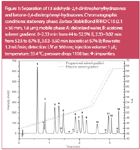High-throughput Method Development for Aldehydes and Ketones Using an Agilent 1290 Infinity LC-system
The Application Notebook
This application note deals with the development of a fast method for the determination of 13 aldehyde and ketone derivates with the Agilent 1290 Infinity LC-system. The method, which used acetone as organic co-solvent, separates the analytes within 3.5 minutes.
Introduction
Aldehydes and ketones are important compounds in the chemical industry. The majority of analytical methods for their determination makes use of the derivatization with 2,4-dinitrophenylhydrazine yielding the corresponding 2,4-dinitrophenylhydrazone. After that, an HPLC separation with UV detection is performed.
Experimental
LC-system
For method development, an Agilent 1290 Infinity LC-system was used. The system consists of: 1290 Infinity binary pump with integrated degasser, 1290 Infinity high performance autosampler, TCC SL thermal controlled column compartment, 1290 Infinity diode array detector
Analyte mixture
The mixture of aldehyde-2,4-dinitrophenylhydrazones and ketone-2,4-dinitrophenyl-hydrazones is a certified reference material from Sigma-Aldrich (catalogue no. 47651-U) diluted in acetonitrile. In the mixture, each analyte has a concentration of 30 µg/mL of carbon of aldehydes and ketones, respectively.
Results and Discussion
Figure 1 shows the separation of 13 aldehyde-2,4-dinitrophenylhydrazones and ketone-2,4-dinitrophenyl-hydrazones within 3.5 minutes. Acetone was used as organic co-solvent. All peaks are baseline separated with a critical resolution of 1.6 between peak pair 7/8. Moreover, Figure 1 also shows a comparison of programmed and effective solvent gradient. Due to the very small dwell volume of 125 µL of the Agilent 1290 Infinity LC system, there is only a minor difference between the programmed and effective solvent gradient when compared to a conventional HPLC-system, which exhibits a dwell volume of approximately 1000 µL. This means that at a flow rate of 1.2 mL/min, the programmed solvent gradient for a conventional HPLC system reaches the column inlet with a delay of about 0.83 minutes, so that the elution of the early eluting analytes occurs under isocratic conditions. In other words, the elution of the early eluting analytes cannot be affected by the solvent gradient. Using the Agilent 1290 Infinity LC-system with a dwell volume of 125 µL at a flow rate of 1.2 mL/min, the programmed solvent gradient reaches the column inlet after 6.25 seconds and enables fast separations within a few minutes.

Due to the applied flow rate of 1.2 mL/min and the 1.8 µm particle packed column, a pressure drop of 1100 bar during the solvent gradient can be observed. To constitute the robustness and reproducibility of the developed method 10 consecutive chromatograms were compared. There were virtually no differences between the 10 chromatograms (not shown). This conclusion is also confirmed by the relative standard deviation (RSD) of retention times of the analytes, which is in a range between 0.03 and 0.09%.
Conclusion
It could be shown that the Agilent 1290 Infinity LC-system is very suitable to develop fast HPLC methods. The separation of 13 aldehyde and ketone derivatives succeeded in around 3.5 minutes by using acetone as organic modifier in the mobile phase. Furthermore, the presented method highlights that fast HPLC separations are only possible using HPLC-systems with a very small dwell volume.

Agilent Technologies Inc.
Hewlett-Packard-Str. 8, PO Box 1280
D-76337 Waldbronn, Germany
tel. +49 7243 602 2107 fax +49 7243 602 2501
Website: www.agilent.com

Free Poster: NDSRI Risk Assessment and Trace-Level Analysis of N-Nitrosamines
April 25th 2025With increasing concern over genotoxic nitrosamine contaminants, regulatory bodies like the FDA and EMA have introduced strict guidelines following several high-profile drug recalls. This poster showcases a case study where LGC and Waters developed a UPLC/MS/MS method for quantifying trace levels of N-nitroso-sertraline in sertraline using Waters mass spectrometry and LGC reference standards.
New TRC Facility Accelerates Innovation and Delivery
April 25th 2025We’ve expanded our capabilities with a state-of-the-art, 200,000 sq ft TRC facility in Toronto, completed in 2024 and staffed by over 100 PhD- and MSc-level scientists. This investment enables the development of more innovative compounds, a broader catalogue and custom offering, and streamlined operations for faster delivery. • Our extensive range of over 100,000 high-quality research chemicals—including APIs, metabolites, and impurities in both native and stable isotope-labelled forms—provides essential tools for uncovering molecular disease mechanisms and exploring new opportunities for therapeutic intervention.
New Guide: Characterising Impurity Standards – What Defines “Good Enough?”
April 25th 2025Impurity reference standards (IRSs) are essential for accurately identifying and quantifying impurities in pharmaceutical development and manufacturing. Yet, with limited regulatory guidance on how much characterisation is truly required for different applications, selecting the right standard can be challenging. To help, LGC has developed a new interactive multimedia guide, packed with expert insights to support your decision-making and give you greater confidence when choosing the right IRS for your specific needs.
Using the Carcinogenic Potency Categorisation Approach (CPCA) to Classify N-nitrosamine Impurities
April 25th 2025Learn how to manage nitrosamine impurities in pharmaceuticals with our free infographic. Discover how the CPCA approach establishes acceptable intake limits and guides the selection of NDSRI reference samples. Stay compliant and ensure safety with our ISO-accredited standards.

.png&w=3840&q=75)

.png&w=3840&q=75)



.png&w=3840&q=75)



.png&w=3840&q=75)













